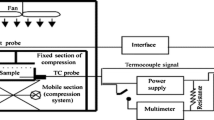Abstract
The availability of thermo-physical data of foods and their constituents is of general importance to food industry. The thermal effusivity e is one among the relevant thermodynamical quantities. The latter is normally calculated from the relationship e = (κρc)½, where c is specific heat, ρ is the density, and κ is the thermal conductivity. The necessity for performing the time consuming independent measurements of these three quantities is the major reason that the existing database with effusivity of foods is not very wide. This paper describes the application of the inverse photopyroelectric (IPPE) technique that allows the determination of effusivity from a single measurement. This approach was used to directly measure thermal effusivity of fresh egg yolk, egg white, and white/yolk blends. In addition, thermal effusivity of rehydrated egg powders (white, yolk, and the whole egg powder) has been measured and compared to that of the fresh hen egg. In case of the egg white, effusivity of rehydrated egg powders was practically the same as that of the fresh egg. However, the difference in effusivity between fresh egg yolk and rehydrated egg yolk, and between the blend of fresh egg and the rehydrated whole egg power was significant. Finally, thermal effusivity of rehydrated egg yolk, egg white, and the whole egg powder was determined as a function of dilution factor.



Similar content being viewed by others
References
Watkins BA. The nutritive value of the egg. In: Stadelman WJ, Cotterill OJ, editors. Egg science and technology. New York: The Haworth Press; 1995. p. 177–85.
Powrie WD. Chemistry of eggs and egg product. In: Stadelman WJ, Cotterill OJ, editors. Egg science & technology. Westport: AVI Publishing; 1977. p. 67–108.
Németh Cs, Friedrich L, Horváth K, Pásztor-Huszár K, Balla Cs. Calorimetric analysis of egg white products preserved by different methods. J Food Phys. 2009;22:17–23.
Nohara D, Mizutani A, Sakai T. Kinetic study on thermal denaturation of hen involving precipitation egg-white lysozyme. J Biosci Bioeng. 1999;87:199–205.
French NA. Modelling incubation temperature: the effects of incubator design, embryonic development, and egg size. Poult Sci. 1997;76:124–33.
Coimbra JSR, Gabas AL, Minim LA, Garcia-Rojas EE, Telis VRN, Telis-Romero J. Density, heat capacity and thermal conductivity of liquid egg products. J Food Eng. 2006;74:186–90.
Jury V, Monteau JY, Comiti J, Le-Bail A. Determination and prediction of thermal conductivity of frozen part baked bread during thawing and baking. Food Res Int. 2007;40:874–82.
Rahman MS. Evaluation of the precision of the modified Fitch method for thermal conductivity measurement of foods. J Food Eng. 1991;14:71–82.
Gustavsson M, Gustafsson SE. Thermal conductivity as an indicator of fat content in milk. Thermochim Acta. 2006;442:1–5.
Peralta Rodriguez RD, Rodrigo M, Kelly P. A Calorimetric method to determine specific heats of prepared foods. J Food Eng. 1995;26:81–96.
Kemp RM, North MF, Leath SR. Component heat capacities for lamb, beaf and pork at elevated temperatures. J Food Eng. 2009;92:280–94.
Marinelli M, Murtas F, Mecozzi MG, Zammit U, Pizzoferrato R, Scudieri F, Martellucci S, Marinelli M. Simultaneous determination of specific heat, thermal conductivity and thermal diffusivity at low temperature via the photopyroelectric technique. Appl Phys A. 1990;51:387–93.
Dadarlat D, Pop MN, Onija O, Streza M, Pop MM, Longuemart S, Depriester M, Sahraoui AH, Simon V. Photopyroelectric (PPE) calorimetry of composite materials. J Therm Anal Calorim. 2013;111:1129–32.
Salazar A, Sanchez-Lavega A, Ocariz A, Guitonny J, Pandey GC, Fournier D, Boccara AC. Thermal diffusivity of anisotropic materials by photothermal methods. J Appl Phys. 1996;79:3984–93.
Dadarlat D. Contact and non-contact photothermal calorimetryfor investigation of condensed matter. J Therm Anal Calorim. 2012;110:27–35.
Rodríguez P, González de la Cruz G. Photoacoustic measurements of thermal diffusivity of amylose, amylopectin and starch. J Food Eng. 2003;58:205–9.
Michaelian KH, Hall RH, Tim Bulmer J. Photoacoustic infrared spectroscopy and thermophysical properties of syncrude cokes. J Therm Anal Calorim. 2002;69:135–47.
Bicanic D, Chirtoc M, Dadarlat D, Chirtoc I, van Loon W, Bot G. Measurement of the heat penetration coefficient (κρc)1/2 in margarine and cultered milk products by the inverse photopyroelectric technique. Int Dairy J. 1994;4:555–65.
Dadarlat D, Bicanic D, Visser H, Mercuri F. Photopyroelectric method for determination of thermophysical parameters and detection of phase transitions in fatty acids and triglycerides. Part I: principles, theory, and instrumentation concepts. J Am Oil Chem Soc. 1995;72:273–9.
Dadarlat D, Gibkes J, Bicanic D, Pasca A. Photopyroelectric (PPE) measurement of thermal parameters in food products. J Food Eng. 1996;30:155–62.
Mandelis A, Zver MM. Theory of photopyroelectric spectroscopy of solids. J Appl Phys. 1985;57:4421–30.
Marinelli M, Zammit Z, Mercuri F, Pizzoferrato R. High-resolution simultaneous photothermal measurements of thermal parameters at a phase transition with the photopyroelectric technique. J Appl Phys. 1992;72:1096–100.
Bicanic D, Chirtoc M, Dadarlat D, van Bovenkamp P, van Schyk H. Direct determination of thermophysical parameter \( \sqrt {K\rho {\text{c}}} \) in mayonnaise, shortening, and edible oil. Appl Spectrosc. 1992;46:602–5.
Eszes F, Dóka O, Kispéter J. Determination of thermal diffusion coefficient of egg powders. J Food Phys. 1998–1999;11:27–37. [in Hungarian].
Author information
Authors and Affiliations
Corresponding author
Rights and permissions
About this article
Cite this article
Szafner, G., Németh, C., Bicanic, D. et al. Photopyroelectric assessment of the thermal effusivity of fresh hen egg and of rehydrated egg powders. J Therm Anal Calorim 120, 363–368 (2015). https://doi.org/10.1007/s10973-014-3927-8
Received:
Accepted:
Published:
Issue Date:
DOI: https://doi.org/10.1007/s10973-014-3927-8




